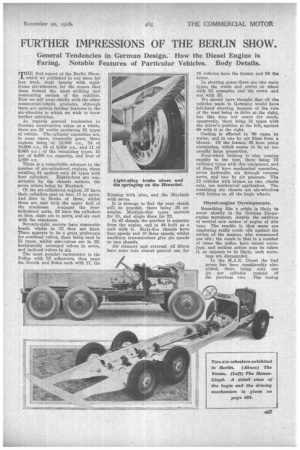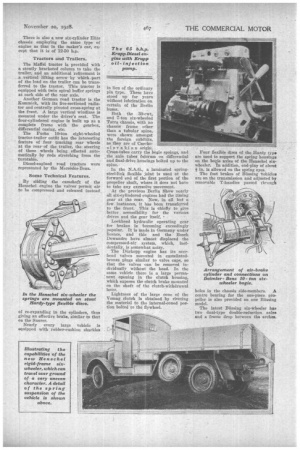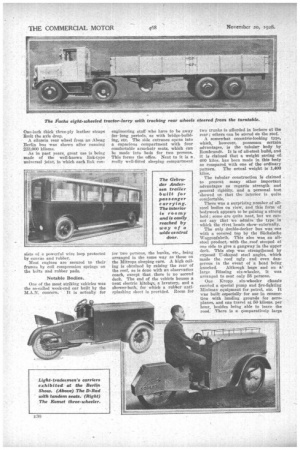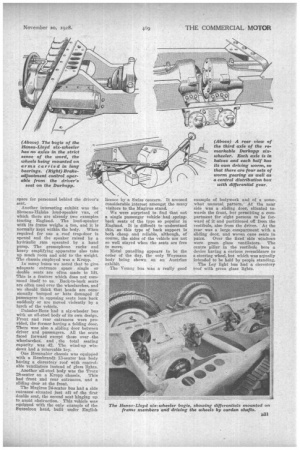FURTHER IMPRESSIONS OF THE BERLIN SHOW.
Page 23

Page 24

Page 25

Page 26

Page 27

If you've noticed an error in this article please click here to report it so we can fix it.
General Tendencies in German Design. How the Diesel Engine is Faring. Notable Features of Particular Vehicles. Body Details.
TEE first report of the Berlin Show, which we published in our issue for last week, dealt largely with rigidframe six-wheelers, for the reason that these formed the most striking and dominating section of the exhibits. Now we will treat chiefly with the other commercial-vehicle products, although there are certain further features in the six-wheelers to which we wish to draw further attention.
As regards general tendencies in German construction taken as a whole, there are 22 works producing 91 types of vehicle. The cylinder capacities are, in some cases, unusually great, three engines being, of 12,000 c.c.,. 24 of 10,000 cc.. 34 of 8,000 c.c., and 11 of 6,000 c.c.of the remaining types, 15 are of 4,00 e.e, capacity, and four of 2,000 c.c.
There is a remarkable advance in the number of six-cylindered engines, these totalling 51 against only 40 types with four cylinders. Eighty-four are constructed by the chassis makers, the seven others being by Ilaybach.
Of the six-eylindered engines, 27 have their cylinders cast en bloc, 17 in pairs, and four in blocks of three, whilst three are cast with the upper half of the crankcase. Amongst the fourcylindered units, 26 have the cylinders en bloc, eight are in pairs, and six cast with the crankcase.
Seventy-eight motors have removable heads, whilst in 12 they are fixed. There appears to be a great preference for overhead valves, these being used in 53 types whilst side-valves are in 25, horizontally arranged valves in seven, and inclined valves in six.
The most popular carburetter is the Pallas with 53 adherents, then come the Zenith and Soles each with 17, the Bussing with nine, and the Maybach with seven.
It is strange to find the cone clutch still so popular, there being 36 examples. Multiple-disc types account for 31, and single discs for 22, In 45 chassis the gearbox is separate from the engine, and in 44 built as a unit with it. Sixty-five chassis have four speeds and 19 three speeds, whilst auxiliary transmissions give six speeds to two chassis.
Air cleaners and external oil filters have come into almost general use, for 75 vehicles have the former and 56 the latter.
In steering gears there are two main types, the worm and sector or wheel with 53 examples and the screw and nut with 38.
We should have thought that all the vehicles made in Germany would have left-hand steering, because of the rule of the road`being to drive at the right, but this does not count for much, apparently, there being 31 types with the driver's position at the left, against 60 with it at the right
Cooling is effected in 90 cases by water, and in one by air blast from a blower. Of the former, 85 have Pump circulation, which seems to be an unusually large proportion.
Four-wheel braking is 'also coming rapidly to the fore, there being 72 ordinary types with this equipment, and of these 57 have mechanical operation, seven hydraulic, six through vacuum servo, and two by air pressure. The 13 vehicles with brakes on two •.vheels only, use mechanical application. The remaining six. chassis are six-wheelers with brakes an all the bogie wheels.
Diesel-engine Developments.
Something like a crisis is likely to occur shortly in the German Dieselengine movement, despite the addition of several new makes of engine of this type. The trouble is that users are employing really crude oils against the advice of the makers, who recommend gas oils ; the result is that in a number of eases the police have issued warnings, and serious action may be taken if, as appears to be likely, such warnings are disregarded.
In the MAN. Diesel the fuel pump has been considerably simplified, there being only one jet per cylinder instead of the previous two. The timing
of the fuel entry has also been abolished, the sole control being by the quantity injected. We were told by Mr, Maximilian Gercke that he did not think it possible to get much below 20 lb. weight per brake horse-power and retain mechanical efficiency. As a matter of fact, the new M.A.N. is slightly heavier than formerly.
A striking flew Diesel unit of remarkably clear design has been developed by Krupp. It develops 65 b.h.p. at 1,000 r.p.m., and weighs 8 kilos. 300 grammes per. .b.h.p. The bore and stroke are 135 ram. and 165 ram. respectively, and the fuel consumption is 185 gramme's per b.h.p.-hour. The low weight of this engine is attained by casting the .cylinder block with the upper half of the crankcase in light alloy, using ironsleeves and cylinder beads. The oil pump is also of Krupp make.
We found the new Dents Diesel engine in four and six-cylindered models, but this was recently dealt with in detail, so we will not say more than that its appearance is clean and both types closely resemble petrol engines.
The Junkers opposed-piston engine is now 'fairly well known and is being manufactured in Paris under licence. We noted with interest a part-sectioned working example of the two-cylindered type of 48 b.h.p.. brt a three-cylindered model of 70 b.h.p. was also on view. In neither are valves employed, the engine working on the two-stroke cycle principle with inlet and exhaust parts in the cylinder walls.
We were not particularly impressed with the Linke Diesel engine, in which each cylinder has its own pump driven by a common crankshaft. It struck us that for motor work it would be rather heavy, and there was a coarseness about the construction which may' however, be improved in later models.
The Mercedk-Senz was, of course, prominent, together with a large photo of the cup which it recently won in England.
A hefty Maybach unit was shown in the private-car section, but it looked too large for the ordinary vehicle.
Interesting Chassis.
One of the most unusual chassis at the Show was described in detail by us a few weeks ago. We refer to the Vornag, with its front-wheel-drive unit, which can be removed complete from the main frame, and its lack of a back axle. The rear wheels are carried by axle pins mounted in stout tubular-steel members, each of which fulcrums at its front end in two bearings, whilst the rear end swivels on a pin passing through a stout bracket bolted to the centre of the springs. These brackets
are bolted through to a back-to-back chassis cross-member.
The N.A.G. six-cylindered bus chassis was shown with an electrically controlled epicyclic gearbox with annular electro-magnets. This gear Was operated by a simple knob close to the steering Wheel. It gives three speeds. ' In the D.A.A.G., the engine has six cylinders cast in threes and a gearbox by Zahnradfabrik. The chassis is rendered particularly low by reducing the rear-axle height by dropping its centre and driving the axle shafts by enclosed spur gearing within the axle casing. The suspension is by huge underslung semi-elliptic springs, each with six leaves above the main leaf. For goods work this rear axle is merely turned over until the centre is lifted instead of dropped.
Another vehicle with a dual-type axle is the Diirkopp, in which the final drive is by spur gearing.
We do not remember having seen a Ley chassis before ; it is a neat twotonner with a six-eylindered monobloc engine built as a neat unit with a central-change gearbox, behind which is on internal expanding transmission
brake. A two-piece propeller shaft takes the drive to a vertical banjo Rite with spiral-bevel final drive. The brakes are operated by oil on the Lockheed system. There is also a new six-cylinder Elite chassis employing the same type of engine as that in the maker's car, except that it is of 12-50 h.p.
Tractors and Trailers.
The Maffei tractor is provided with a stoutly bracketed column to take the trailer, and an additional refinement is a vertical lifting screw by which -part of the load on the trailer can be transferred to the tractor. This tractor is equipped with twin spiral buffer springs at each side of the rear axle.
Another German road tractor is the Kommick, with its five-sectioned radiator and centrally pivoted cross-spring at the front. A large vertical windlass is mounted under the driver's seat. The four-cylindered engine is built up as a complete frame with the gearbox, differential casing, etc.
The Fuchs 10-ton eight-wheeled tractor-trailer outfit has the interesting feature of four tracking rear wheels at the rear of the trailer, the steering of these wheels being effected automatically by rods stretching from the turntable.
Diesel-engined road tractors were represented by the Mercedes-Benz.
Some Technical Features.
By sliding the camshaft of the Henschel engine the valves permit air to be compressed and released instead, of re-expanding in the cylinders, thus giving an effective brake, similar to that on the Sewer.
Nearly every large vehicle is equipped with rubber-cushion shackles in lieu of the ordivary pin type. These have stood up for years without lubrication on certain of the Berlin buses.
Both the 30-cwt, and 7-ton six-wheeled Tatra chassis, with no chassis frame other than a tubular spine, were shown amongst the foreign exhibits, as they are of Czechoslovakian origin. Cross-tubes carry the bogie wings, and the axle tubes fulcrum on differentialand final-drive housings bolted up to the spine.
In the N.A.G., a laminated springsteel-link flexible joint is used at the forward end of the first portion of the propeller shaft, where it does not have to take any excessive movement.
At the previous Berlin Show nearly all six-cylindered engines had the timing gear at the rear. Now, in all but a few instances, it has been transferred to the front. This is chiefly to give better accessibility for the various drives and the gear itself. • Lockheed hydraulic operating gear for brakes is becoming exceedingly popular. It is made in Germany under licence, and this and the Bosch Dewandre have almost displaced the compressed-air system, which, incidentally, is somewhat noisy.
The Diirkopp engine has its overhead valves mounted in castellatedbronze plugs similar to valve caps, so that the valves can be removed individually without the head. In the same vehicle there is a large permanent opening in the clutch housing, which exposes the clutch brake mounted on the shaft of the clutch-withdrawal lever.
Lightness of the large cone of the Tomag clutch is obtained by riveting the material to the internal-coned portion bolted to the flywheel. Four flexible discs of the Hardy qt.)* are used to support the spring housings on the bogie axles of the Henschel sixwheeler. In addition, end-play of about in. is allowed on the spring eyes.
The foot brakes of Bussing 'vehicles are on the transmission and adjusted by removable T-handies passed through holes in the chassis side-members. A centre bearing for the one-piece propeller is also provided on one Bussing model.
The latest Bussing six-wheeler has two dual-type double-reduction axles and a frame drop between the arches. One-inch thick three-ply leather straps limit the axle drop.
A siIumin rear wheel from an Aboag Berlin bus was shown after running 233,000 kiloms.
As in past years, great use is being made of the well-known link-type universal joint, in which each link eon sista of a powerful wire loop protected by canvas and rubber.
Most engines are secured to their frames by coil compression springs on the bolts and rubber pads. .
Notable Bodies.
One of the most striking vehicles was the so-called week-end car built by the M.A.N. Concern. It is actually for engineering staff who have to be away for long periods, as with bridge-building, etc. The side entrance opens into a capacious compartment with four comfortable armchair seats, which can be made into beds for two persons. This forms the office. Next to it is a really well-fitted sleeping compartment
ior two persons, the bunks, etc., .being arranged in the same way as those on the Mitropa sleeping cars. A high ceiling is obtained by raising the rear of the roof, as is done with an observation coach, except that there is no second deck. The end of the vehicle houses a neat electric kitehro, a lavatory, and a shower-bath, for whicha rubber antisplashing sheet is provided. Room for
two trunks is afforded in lockers at the rear ; others can be stored on the roof.
A somewhat eccentric-looking type, which, however, possesses certain advantages, is the tubular body by Rembrandt. It is of all-steel build, and it is claimed that a weight saving of 400 kilos. has been made in this body as compared with one of the ordinary pattern. The actual weight is 1,401) kilos.
The tubular construction is claimed to present many other important advantages as regards strength and ,general rigidity, and a personal test showed us that the interior is quite comfortable.
There was a surprising number of allsteel bodies on view, and this form of bodywork appears to be gaining a strong hold; some are quite neat, but we cannot say that we admire the type in which the rivet heads showexternally.
The only double-decker bus was one with a covered top by the Sfichsische Wag,gonfabrik. This also was an allsteel product, with the,roof steeped at one side to give a gangway in the upper deck. This step was strengthened by exposed U-shaped steel angles, which made the roof ugly and even dangerous in the event of a bead being
knocked. Although huge and on alarge Bussing six-wheeler, it was arranged to seat only 58 persons.
One Krupp six-wheeler chassis carried a special pump and fire-fighting Minimax equipment for petrol, etc. It was built especially for use in connection with landing grounds for aeroplanes, and can travel at 50 kiloms. per hour, besides being able to leave the road. There is a comparatively large
space for personnel behind the driver's seat.
Another interesting exhibit was the Siemens-Halske loud-speaker van, of which there are already two examples touring England. The loud-speaker with its frame weighs a ton, and it is normally kept within the body. When required for use a roof trap-door is opened and the speaker raised by a hydraulic ram operated by a hand pump. The gramophone racks and heavy amplifying apparatus also take up much room and add to the weight The chassis employed was a Krupp.
In many buses we noted that to give adequate • entrance space single or double seats are often made to lift. This is a feature which does not commend itself to us. Back-to-back seats are often used over the wheelarches, and we should think that heads are occasionally bumped or hats damaged if passengers in opposing seats lean back suddenly or are moved violently by a lurch of the vehicle.
Daimler-Benz had a six-wheeler bus with an all-steel body of its own design. Front and rear entrances were provided, the former having a folding door. There was also a sliding door between driver and passengers. All the seats faced forward except those over -the wheelarches, and , the total seating capacity was 42. The wind-up win dows had a removable key. .
One Brennabbr chassis was equipped with a Rembrandt 13-seater' bus body having a clerestory roof with controlable ventilators instead of glass lights.
Another all-steel body was the Trutz 28-seater on a Krupp chassis. This had front and 'rear entrances, and a sliding door at the front.
The Magirus 24-seater bus had a side entrance _situated just aft of . the first double seat; the second seat hinging up to avoid obstruction. This vehicle was equipped with the only example of the Sansaloon head, built under English licence by a Swiss concern. It aroused considerable interest amongst the many visitors to the Magirus stand.
We were surprised to find that not a single passenger vehicle had springback seats of the type so popular in England. It is difficult to understand this, as this type of back support is both cheap and reliable, although, of course, the sides of the vehicle are not so well stayed when the seats are free to move.
Metal panelling appears to be the order of the day, the only Weymann body being shown on an Austrian exhibit.
The Voinag bus was a realty good example of bodywork and of a somewhat unusual pattern. At the near side was a sliding door, situated towards the front, but permitting a compartment for eight persons to be forward of it and partitioned off from the vestibule, also from the driver. At the rear was a large compartment with a sliding door, and woven cane seats in
pairs. Over the fixed side windows were green glass ventilators. The centre pillar in the vestibule bore a device having a curious resemblance to a steering wheel, but which was actually intended to be held by people standing.
The Ley light bus had a clerestory roof with green glass lights.








































